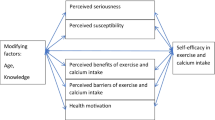Abstract
A survey of a random sample of 1514 Norwegian women and men aged 16–79 years was undertaken to investigate knowledge of osteoporosis and attitudes towards methods for preventing this disease. The interviews were carried out by Central Bureau of Statistics of Norway as part of their monthly national poll using a structured questionnaire. Women knew more about osteoporosis than did men (p<01). In both men and women increased knowledge of osteoporosis was correlated to a high level of education. Furthermore it was clearly demonstrated that knowing someone with osteoporosis or suffering from it oneself increased the knowledge of osteoporosis significantly in both women and men. Multiple regression analysis confirmed the univariate analyses, and education was the strongest predictive factor for knowledge. To a hypothetical question as many as two-thirds of the women answered that they would use long-term hormone replacement therapy (HRT) to prevent osteoporosis on the recommendation of their general practitioner. Their attitudes towards the use of estrogen therapy did not show any significant relation to age, but their reluctance towards HRT increased with education (p<001). When asked a question about their preferences regarding the use of physical activity as a means to prevent osteoporosis, older women preferred walking (p<.001), whereas younger women wanted more organized athletic activity (p<001). The data demonstrated that there was a high degree of general knowledge of osteoporosis and its consequences in the general population.
Similar content being viewed by others
References
Riggs BL, Melton LJ III. Involutional osteoporosis. N Engl J Med 1986;314:1676–86.
Riggs BL, Melton LJ III. The prevention and treatment of osteoporosis. N Engl J Med 1992;327:620–7.
McBean LD, Forgac T, Finn SC. Osteoporosis: visions for care and prevention: a conference report. J Am Diet Assoc 1994;94:668–71.
Melton LJ III, Chrischilles EA, Cooper C, Lane AW, Riggs BL. How many women have osteoporosis? J Bone Miner Res 1992;7:1005–9.
Cummings S, Kelsey J, Nevitt M, O'Down K. Epidemiology of osteoporosis and osteoporotic fractures. Epidemiol Rev 1985;7:178–208.
Wasmuth HH, Reikerås O, Roald HE. The epidemiology of hip fractures in the county of Troms and the city of Oslo. Tidsskr Nor Lægeforen 1992;112:190–3.
Parkkari J, Kannus P, Niemi S, Pasanen M, Jarvinen, Luthje P, Vuori I. Increased age-adjusted incidence of hip fractures in Finland: the number and incidence of fractures in 1970–1991 and prediction for the future. Calcif Tissue Int 1994;55:342–5.
Draper J, Roland M. Perimenopausal women's views on taking hormone replacement therapy to prevent osteoporosis. BMJ 1990;300:786–8.
Hunskaar S, Backe B. Attitudes towards the level of information on perimenopausal and postmenopausal hormone replacement therapy among Norwegian women. Maturitas 1992;15:183–94.
Central Bureau of Statistics. Prinsipper og metoder for SSB's utvalgsunders økelser. Samfunnsøkonomiske studier (SØS) nr. 33. Oslo: Statistisk Sentralbyrå, 1980.
Central Bureau of Statistics. Dokumentasjonsrapport. SSB Omnibus mars 1994. Seksjon for intervjuundersøkelser, Oslo: Statistisk Sentralbyrå, 1994.
Fylkesnes K. Determinants of health care utilization: visits and referrals. Scand J Soc Med 1993;21:40–50.
Sinclair HK, Bond CM, Taylor RJ. Hormone therapy: a study of women's knowledge and attitudes. Br J Gen Pract 1993;43:365–70.
Ferguson KJ, Hoegh C, Johnson S. Estrogen replacement therapy: a survey of women's knowledge and attitudes. Arch Intern Med 1989;149:133–6.
Ringa V, Ledésert B, Bréart G. Determinants of hormone replacement therapy among postmenopausal women enrolled in the French GAZEL cohort. Osteoporosis Int 1994;4:16–20.
Ryan PJ, Harrison R, Blake GM, Fogelman I. Compliance with hormone replacement therapy (HRT) after screening for postmenopausal osteoporosis. Br J Obstet Gynaecol 1992;99:325–8.
Gutin B, Kaspar MJ. Can vigorous exercise play a role in osteoporosis prevention? Osteoporosis Int 1992;2:55–69.
Krall EA, Dawson-Hughes B. Walking is related to bone density and rates of bone loss. Am J Med 1994;96:20–6.
Seeman E. Osteoporosis in men: epidemiology, pathophysiology, and treatment possibilities. Am J Med 1993;95 (Suppl 5A):22S-28S.
Author information
Authors and Affiliations
Rights and permissions
About this article
Cite this article
Magnus, J.H., Joakimsen, R.M., Berntsen, G.K. et al. What do Norwegian women and men know about osteoporosis?. Osteoporosis Int 6, 31–36 (1996). https://doi.org/10.1007/BF01626535
Received:
Accepted:
Issue Date:
DOI: https://doi.org/10.1007/BF01626535



